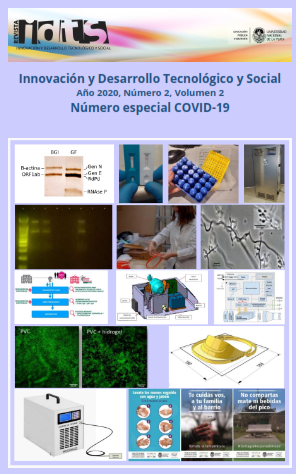Ozone generator for the destruction of viral load in public environments
DOI:
https://doi.org/10.24215/26838559e022Keywords:
ozone, disinfection, viral load, control engineeringAbstract
A device capable of generating large amounts of ozone in a controlled manner is being developed. The device is equipped with a battery of sensors that allows it to interact with the environment until the ozone injected reaches the appropriate concentration to guarantee the destruction of the viral load in a closed environment. It was developed by the Technology Transfer area of the Argentine Institute of Radio Astronomy (IAR) with the aim of providing a disinfection tool for use in close spaces of frequent human occupation during the period of return to face-to-face work and educational activity at the end of the COVID-19 pandemic. The disinfection of classrooms, offices, transport vehicles, dining rooms, laboratories, and other closed spaces between two successive occupations of users tends to minimize the possibilities of uncontrolled outbreaks and infections. The equipment is designed to destroy bacteria, spores, fungi and to be very effective in the inactivation of other species of microorganisms since its main mode is the direct oxidation of the cell wall. It is capable, by achieving the appropriate concentrations of ozone, of neutralizing all types of viruses, both in air and on surfaces. This document describes the device, the technology used, its effectiveness, and the most efficient way to apply it.
Downloads
References
Dubuis, M-E., Dumont-Leblond, N., Laliberté, C., Veillette. M., Turgeon, N., Jean, J., et al. (2020) Ozone efficacy for the control of airborne viruses: Bacteriophage and norovirus models. PLoS ONE 15(4): e0231164. https://doi.org/10.1371/journal.pone.0231164
Hudson, J.B., Sharma, M., y Petric, M. (2007). Inactivation of Norovirus by ozone gas in conditions relevant to healthcare. Journal of Hospital Infection, 66, 40-45. https://doi.org/10.1016/j.jhin.2006.12.021
Hudson, J.B., Sharma, M., y Vimalanathan, S. (2009). Development of a practical method for using ozone gas as a virus decontaminating agent. Ozone: Science & Engineering, 31 (3), 216-223. https://doi.org/10.1080/01919510902747969
OMS (2006). Material particulado, el ozono, el dióxido de nitrógeno y el dióxido de azufre. Guías de Calidad del Aire. https://www.who.int/publications/list/who_sde_phe_oeh_06_02/es/
Ono, R. y Oda, T. (2007). Ozone production process in pulsed positive dielectric barrier discharge. Journal of Physics D: Applied Physics, 40, 176–182. https://ui.adsabs.harvard.edu/link_gateway/2007JPhD...40..176O/doi:10.1088/0022-3727/40/1/011
Pékarek, S. (2013). Asymmetric properties and ozone production of surface dielectric barrier discharge with different electrode configurations. The European Physical Journal D, 67: 94, 1-7. https://doi.org/10.1140/epjd/e2013-30723-4
Portugal, S., Roy, S., y Lin, J. (2017). Functional relationship between material property, applied frequency and ozone generation for surface dielectric barrier discharges in atmospheric air. Scientific Reports 7, 6388, 1-11. https://doi.org/10.1038/s41598-017-06038-w
Shinriki, N., Ishizaki, K., Yoshizaki, T., Miura, K., y Ueda, T. (1988). Mechanism of inactivation of tobacco mosaic virus with ozone. Water Research, 22 (7), 933-938.
Zhang, X., Lee, B.J., Im, H.G., y Cha, M.S. (2016). Ozone production with dielectric barrier discharge: Effects of power source and humidity. IEEE Transactions On Plasma Science, 44(10), 2288-2296. https://doi.org/10.1109/TPS.2016.2601246
Downloads
Published
How to Cite
Issue
Section
License
Los autores que publiquen en esta revista aceptan las siguientes condiciones:
La aceptación del manuscrito por parte de la revista implica la no presentación simultánea a otras revistas u órganos editoriales y la cesión no exclusiva de los derechos patrimoniales de los autores en favor del editor, quien permite la reutilización, luego de su edición (postprint), bajo licencia Creative Commons 4.0 (https://creativecommons.org/licenses/by-nc/4.0/deed.es). Usted es libre de:
1) Compartir, copiar y redistribuir el material en cualquier medio o formato.
2) Adaptar, remezclar, transformar y crear a partir del material, bajo los siguientes términos: 1) Atribución — Usted debe darle crédito a esta obra de manera adecuada, proporcionando un enlace a la licencia, e indicando si se han realizado cambios. Puede hacerlo en cualquier forma razonable, pero no de forma tal que sugiera que usted o su uso tienen el apoyo del licenciante. 2) Uso No Comercial — Usted no puede hacer uso del material publicado con fines comerciales.
Los autores pueden realizar otros acuerdos contractuales independientes y adicionales para la distribución no exclusiva de la versión del artículo publicado en esta revista (p. ej., incluirlo en un repositorio institucional o publicarlo en un libro) siempre que indiquen claramente que el trabajo se publicó por primera vez en esta revista.
La responsabilidad de cada trabajo publicado en cuanto a su contenido recae exclusivamente en los autores del mismo, deslindando a los editores de cualquier responsabilidad legal.

















